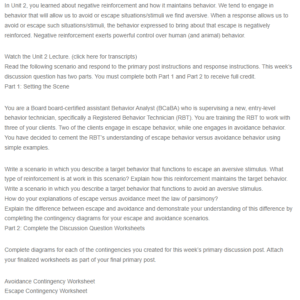Behavior Analysis-Escape and Avoidance
Escape and avoidance behaviors highlight the significance of negative reinforcements in informing behavioral changes. Avoidance behaviors are behaviors that individuals use to distract themselves or escape from situations or feelings that are unfavorable to them (Lemmens et al., 2021). An example of a scenario of avoidance behavior is procrastination. Here, an individual may be trying to achieve something, such as daily tasks like homework or doing the dishes, but fails to act on their intentions.
Escape behaviors are present to avoid, terminate, or delay an unfavorable occurrence. An example of an escape behavior scenario is when a child pushes vegetables around the plate or throws them to the floor to avoid eating them. In this case, the aversive stimulus is eating the vegetables. The child finds eating vegetables unfavorable to them and escapes by pushing them around or throwing them to the floor.
The law of parsimony asserts that the hypothesis with the fewest assumptions is more likely to be selected in the event of competing hypotheses. Parsimony suggests the likelihood for an individual to opt for the simplest possible explanation of a phenomenon. Individuals with escape and avoidance behaviors tend to react differently to specific traits. Individuals with these behaviors view these aversive stimuli as complex phenomena and tend to limit their exposure to these aversive stimuli (Andzik et al., 2020). This aligns with parsimony, which requires individuals to opt for simpler explanations of occurring phenomena.
Escape and avoidance behavior are types of negative reinforcements that differ in their approach. In escape behavior, the manifestation of the escape behavior terminates the aversion stimuli. In avoidance behavior, the occurrence of an animal behavior prevents the manifestation of an aversive stimulus. Avoidance eliminates the stimuli, while escape does not (Sege et al., 2018). Attached is the contingency worksheet for the case scenarios.
References
Andzik, N., Smith, E., & Neef, N. (2020). Using a token economy to treat escape-maintained problem behavior without extinction. Behavior Modification, 46(1), 128–146. https://doi.org/10.1177/0145445520966762
Lemmens, A., Smeets, T., Beckers, T., & Dibbets, P. (2021). Are you avoiding at all costs? An exploration of avoidance costs in a novel virtual reality procedure. Learning and Motivation, 73, 101710. https://doi.org/10.1016/j.lmot.2021.101710
Sege, C. T., Bradley, M. M., & Lang, P. J. (2018). Avoidance and escape: Defensive reactivity and Trait Anxiety. Behavior Research and Therapy, 104, 62–68. https://doi.org/10.1016/j.brat.2018.03.002
ORDER A PLAGIARISM-FREE PAPER HERE
We’ll write everything from scratch
Question
In Unit 2, you learned about negative reinforcement and how it maintains behavior. We tend to engage in behavior that will allow us to avoid or escape situations/stimuli we find aversive. When a response allows us to avoid or escape such situations/stimuli, the behavior expressed to bring about that escape is negatively reinforced. Negative reinforcement exerts powerful control over human (and animal) behavior.

Behavior Analysis-Escape and Avoidance
Watch the Unit 2 Lecture. (click here for transcripts)
Read the following scenario and respond to the primary post instructions and response instructions. This week’s discussion question has two parts. You must complete both Part 1 and Part 2 to receive full credit.
Part 1: Setting the Scene
You are a board-certified assistant behavior analyst (BCaBA) who is supervising a new, entry-level behavior technician, specifically a registered behavior technician (RBT). You are training the RBT to work with three of your clients. Two of the clients engage in escape behavior, while one engages in avoidance behavior. You have decided to cement the RBT’s understanding of escape behavior versus avoidance behavior using simple examples.
Write a scenario in which you describe a target behavior that functions to escape an aversive stimulus. What type of reinforcement is at work in this scenario? Explain how this reinforcement maintains the target behavior.
Write a scenario in which you describe a target behavior that functions to avoid an aversive stimulus.
How do your explanations of escape versus avoidance meet the law of parsimony?
Explain the difference between escape and avoidance and demonstrate your understanding of this difference by completing the contingency diagrams for your escape and avoidance scenarios.
Part 2: Complete the Discussion Question Worksheets
Complete diagrams for each of the contingencies you created for this week’s primary discussion post. Attach your finalized worksheets as part of your final primary post.
Avoidance Contingency Worksheet
Escape Contingency Worksheet

